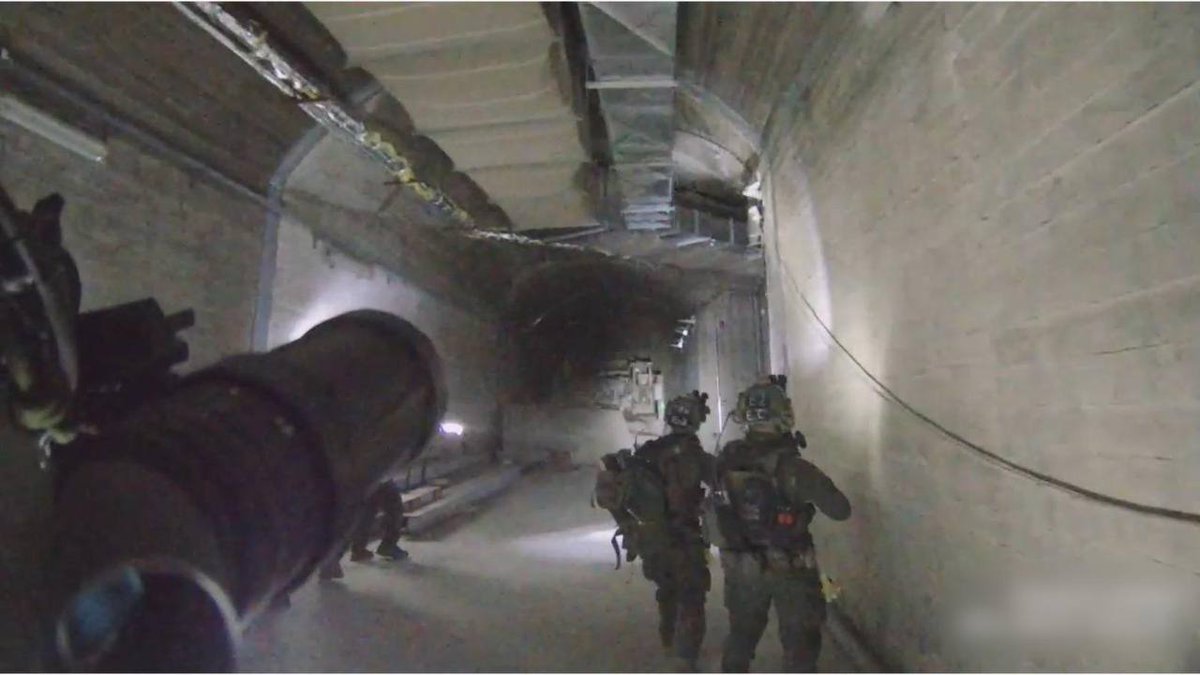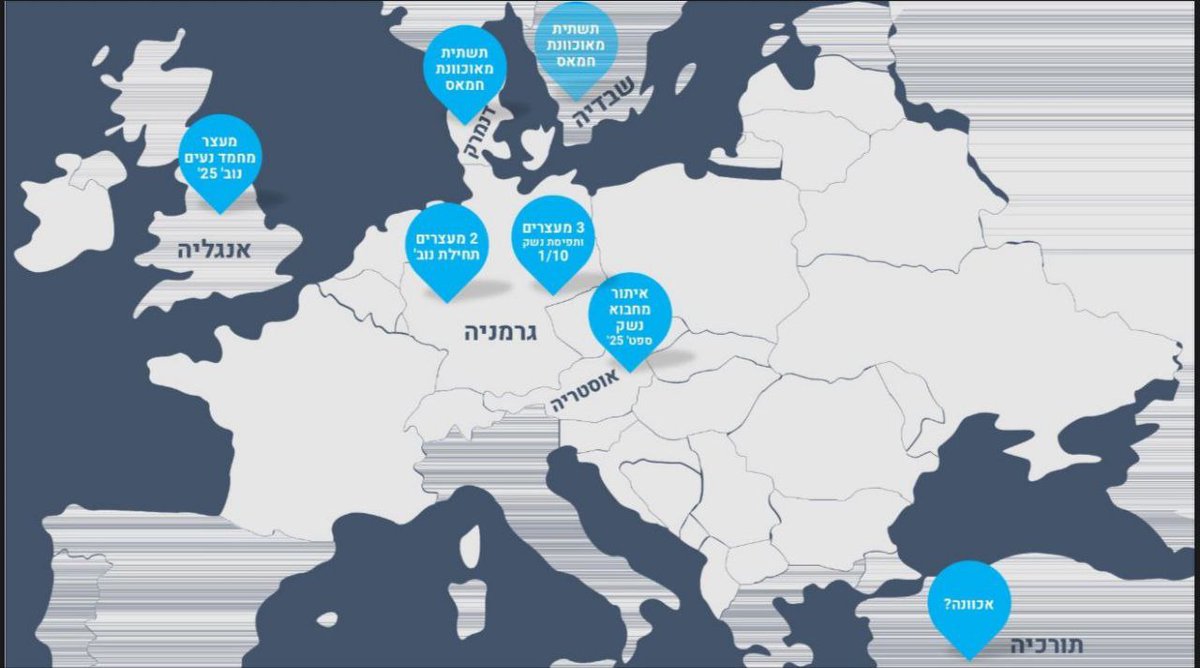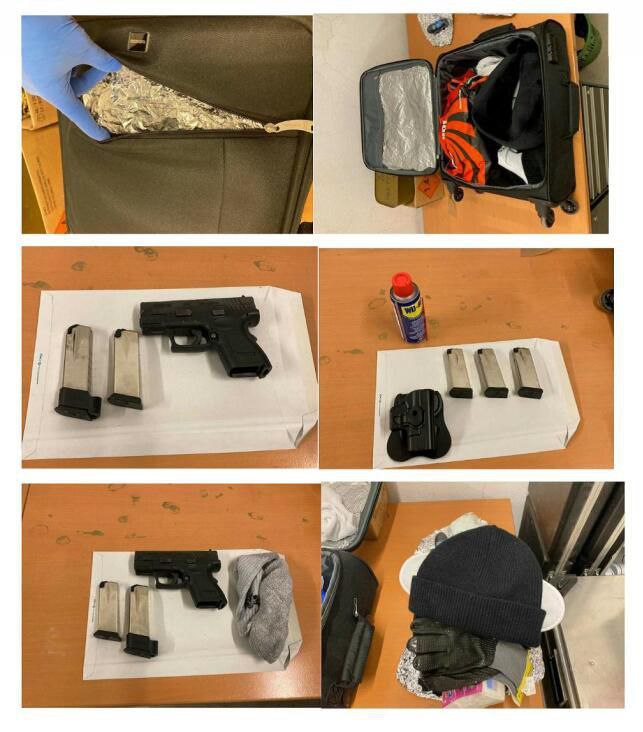🔴 🧵Operation "Many Roads" revealed: The "safe site" breached by Shaldag fighters deep in Syria, the dangerous landing, and the explosion that shook the earth: The IDF is revealing tonight all the details of the secret operation known as "Many Roads" to destroy the Iranian missile production facility on Syrian soil in September 2024.
Target of the operation: The Syrian "Seres" Industries site was the only site in Syria for the production of surface-to-surface missiles. It was supposed to produce 100-300 missiles each year and to be a significant player in arming Hezbollah. It is deep underground, about 70-130 meters dug into the mountainside. The site began to be built in 2017 when excavations started on the mountain. Four years later, in 2021, the excavation work was completed, and the Iranians began sending the advanced production machines. In August 2024—just a month before the operation—initial production of the first missiles started on an experimental basis at the site. Over the past few years, Israel has attacked the facility 4 times—attacks that delayed and disrupted its construction work. The site was intended to produce advanced ballistic missiles with ranges of 70 to 300 km, and all of them were supposed to be sent to Hezbollah in Lebanon. Due to its depth within the mountain, the site has been designated a "safe site" in Israel. Its uniqueness is that the entire production process occurs there from beginning to end: "raw materials enter from one opening, and a missile exits from the other opening."
The decision to carry out the operation: Israeli intelligence officials understood that the site was facing a setback and that advanced missiles would soon be produced there. The understanding was that as the place became an active manufacturing industry, it would become a much more guarded and secure site, and the number of guards and security that the Syrians and Iranians would place there would be multiplied several times. Operation "Many Roads" was an opportunity to seize the opportunity to reach the site on the ground at a stage when it was still relatively lightly guarded—by a few dozen guards while it was on the verge of starting an industrial production process. Preparations for the operation began two months earlier, in July 2024. A month later, engine production had already begun at the site. The IDF says: If we had waited a little longer with the execution, it might have been too late, or the entire operation would have had to look completely different.
The goal of the operation is to destroy as many production machines as possible within the underground site, with the top priority being destroying the planetary mixers, which are the most critical component in the advanced missile production process

The goal of the operation is to destroy as many production machines as possible within the underground site, with the top priority being destroying the planetary mixers, which are the most critical component in the advanced missile production process


The start of the operation—an aerial fire "envelope"
The operation included parallel stages; it began with a large-scale airstrike, which looked like another routine airstrike that Israel has carried out dozens of times in recent years. The attacks aimed to prevent the Syrians from understanding that ground forces were about to land in Masyaf and to cut off access routes to the area—to delay reinforcements that the Syrians might send to the area. The Air Force created a "fire envelope" before the troops landed on the ground. There was also preparation for the situation in which the Russian forces in Syria, who are stationed near Masyaf, would try to disrupt the operation. About 70 aircraft participated in the operation, including fighter jets, transport aircraft, helicopters, and UAVs. About 50 bombs were dropped on the targets.

The operation included parallel stages; it began with a large-scale airstrike, which looked like another routine airstrike that Israel has carried out dozens of times in recent years. The attacks aimed to prevent the Syrians from understanding that ground forces were about to land in Masyaf and to cut off access routes to the area—to delay reinforcements that the Syrians might send to the area. The Air Force created a "fire envelope" before the troops landed on the ground. There was also preparation for the situation in which the Russian forces in Syria, who are stationed near Masyaf, would try to disrupt the operation. About 70 aircraft participated in the operation, including fighter jets, transport aircraft, helicopters, and UAVs. About 50 bombs were dropped on the targets.


Landing of ground forces by helicopters: The Shaldag force numbered about 100 fighters and was at the heart of the operation. It brought another 20 fighters from Unit 669 to Syrian territory.
The 120 fighters arrived in 4 "Yasu'r" helicopters, which took off from Israel and flew for about an hour and a half to reach their destination, including aerial refueling. The flight was over the sea at a very low altitude of only 60 feet. "The helicopters skimmed the sea's surface," said a senior Air Force official. Inside Syrian territory, the flight lasted 18 minutes until landing. The flight was under heavy aerial threats. It was densely packed with dozens of surface-to-air missile batteries, "a hermetically protected area," as an officer in the Intelligence Directorate who was involved in preparations for the operation defined it. "The Syrians defined it as the second most important defense area after Damascus. "Because we flew so low, the surface-to-air missiles were not the only threat, but also anti-tank missiles that could be launched at us from the ground." The fighters were landed at two airfields in the area, which the Air Force analyzed as places where the helicopters could be landed.
The 120 fighters arrived in 4 "Yasu'r" helicopters, which took off from Israel and flew for about an hour and a half to reach their destination, including aerial refueling. The flight was over the sea at a very low altitude of only 60 feet. "The helicopters skimmed the sea's surface," said a senior Air Force official. Inside Syrian territory, the flight lasted 18 minutes until landing. The flight was under heavy aerial threats. It was densely packed with dozens of surface-to-air missile batteries, "a hermetically protected area," as an officer in the Intelligence Directorate who was involved in preparations for the operation defined it. "The Syrians defined it as the second most important defense area after Damascus. "Because we flew so low, the surface-to-air missiles were not the only threat, but also anti-tank missiles that could be launched at us from the ground." The fighters were landed at two airfields in the area, which the Air Force analyzed as places where the helicopters could be landed.
Arrival of the fighters at the underground complex:
The first force to land was about 50 fighters. Their role was to isolate the area and neutralize threats in the region, thus allowing the landing of the second force, which would be the force that would storm the site itself and blow it up. Seven minutes before the first force landed, the Air Force attacked the area to neutralize threats. "We saw the explosions from the air when we were over the mountains on the way to land," said one of the commanders who participated in the operation. The facility did not have too much security—about 30 security guards from the Syrian army at several guard posts, a vehicle with a machine gun stationed at a control point, and an alert squad. The isolation force that landed first reached a control point in the area. The force-operated drones also created control over the area and identified any potential threat or Syrian reinforcements that might arrive.
The second force—the raiding force—landed at another airstrip and had to dash a distance of about 700 meters from the airstrip to the doors of the underground site. "We did everything on the run; we understood that we had to be fast because there wasn't much time," said one of the force's commanders. "The intelligence estimated that within about two and a half hours, an entire Syrian division, hundreds of fighters, could reach the site. Therefore, the time allotted for us to be on the ground was at least two and a half hours."
The first force to land was about 50 fighters. Their role was to isolate the area and neutralize threats in the region, thus allowing the landing of the second force, which would be the force that would storm the site itself and blow it up. Seven minutes before the first force landed, the Air Force attacked the area to neutralize threats. "We saw the explosions from the air when we were over the mountains on the way to land," said one of the commanders who participated in the operation. The facility did not have too much security—about 30 security guards from the Syrian army at several guard posts, a vehicle with a machine gun stationed at a control point, and an alert squad. The isolation force that landed first reached a control point in the area. The force-operated drones also created control over the area and identified any potential threat or Syrian reinforcements that might arrive.
The second force—the raiding force—landed at another airstrip and had to dash a distance of about 700 meters from the airstrip to the doors of the underground site. "We did everything on the run; we understood that we had to be fast because there wasn't much time," said one of the force's commanders. "The intelligence estimated that within about two and a half hours, an entire Syrian division, hundreds of fighters, could reach the site. Therefore, the time allotted for us to be on the ground was at least two and a half hours."
The first challenge—breaking the doors and entering the underground complex: The first challenge facing the forces was the locked doors. The Iranian site was in "night mode," not operating at those hours, and it had three heavy openings—all of them shut and blocked, and it was necessary to break them. The fighters trained for this in advance and began the breaking operations. At the same time, the third force—the sabotage force—made its way from the landing. This force comes with all the explosives and heavy equipment, so it took them longer. The mission was: by the time the sabotage force arrived, the raiding force needed to break the doors so they could enter and start working immediately. The break-in was complete within 45-50 minutes of landing, and the troops entered the underground complex through opening number 3. The clock is ticking—less than two hours left to operate



Seizing Iranian missile production components and gathering intelligence from the site: The forces entered and began a quick scan of the entire complex. There were no people inside. The fighters who entered moved through the missile "production corridor," from room to room, and began sabotage operations: placing the correct charge, of the right size, on each machine, and most importantly—first of all—looking for the mixers, the most critical component for destruction. The three mixers were found in rooms B4, B5, and B6 in the heart of the complex.
The fighters used forklifts inside the site to open the remaining facility openings. This was not an improvisation of the moment: intelligence knew in advance that there were forklifts inside that could be used to break down the doors from the inside, and as part of preparations for the operation, some of the fighters were sent to practice operating a forklift. "I felt at home," one of the fighters later told the intelligence officer in charge of the operation. "Just like you told me, I knew what the place looked like, where the mixers were, and where to place the bomb.
"Meanwhile the bomb squad continues to trap the compound. A suitable charge has been placed in each room. "We did everything on the run," said one of the commanders. The fighters also gathered intelligence material from inside the compound along the way, which confirmed what Israel already knew: this site was a stone's throw from the start of industrial production of ballistic missiles.

The fighters used forklifts inside the site to open the remaining facility openings. This was not an improvisation of the moment: intelligence knew in advance that there were forklifts inside that could be used to break down the doors from the inside, and as part of preparations for the operation, some of the fighters were sent to practice operating a forklift. "I felt at home," one of the fighters later told the intelligence officer in charge of the operation. "Just like you told me, I knew what the place looked like, where the mixers were, and where to place the bomb.
"Meanwhile the bomb squad continues to trap the compound. A suitable charge has been placed in each room. "We did everything on the run," said one of the commanders. The fighters also gathered intelligence material from inside the compound along the way, which confirmed what Israel already knew: this site was a stone's throw from the start of industrial production of ballistic missiles.


Breaking contact—and destruction: After the capture operations were over, and just before breaking contact, several actions needed to be taken: First, ensure that all the fighters were there and that not a single Amed was left behind. And no less important—make sure that the entire sabotage circuit is in order so that, in the end, the place will explode. The forces moved away to the required safety distance, and the unit's coroner pressed the button while the fighters were still on the ground. Almost a ton of explosives exploded there. "We saw the explosion with our own eyes; we felt it like a small earthquake," said one of the commanders. To speed up the departure of the place, the forces left some of their equipment in Syrian territory so that it would not take up space in the return helicopter, such as a special ATV brought in for the operation. The fighters ran back to the helicopters that were waiting for them on the ground and took off with them back, an hour and a half, to Israeli territory.
About an hour after the force left the scene, reinforcements of hundreds of Syrian army fighters arrived at the scene. They were on their way, which makes it clear how dangerous the operation was. Hundreds of Syrian army forces faced a small force of 120 IDF commandos. According to the IDF's estimate, a total of about 30 enemy personnel were eliminated during the operation, who were, in fact, the original security force that guarded the facility, and a few more who tried to reach the area while the troops were operating.
About an hour after the force left the scene, reinforcements of hundreds of Syrian army fighters arrived at the scene. They were on their way, which makes it clear how dangerous the operation was. Hundreds of Syrian army forces faced a small force of 120 IDF commandos. According to the IDF's estimate, a total of about 30 enemy personnel were eliminated during the operation, who were, in fact, the original security force that guarded the facility, and a few more who tried to reach the area while the troops were operating.
Preparations for unforseen events: The operation was completed without casualties to our forces. None of the fighters were injured, but the Air Force also prepared for the possibility that fighters would be wounded in the operation. A "flying operating room" was brought in by helicopters, which could provide an urgent response in Syria to several fighters in critical condition. However, due to the importance and complexity of the operation, the wounded were supposed to receive treatment in the field and return with the rest of the force back to Israel without flying them separately to Israel. As mentioned, the entire force returned home safely.
The forces that participated in the operation:
Two senior commanders also participated in the operation on the ground in Syria: Colonel T., the commander of Wing 7, the Air Force's Special Forces Wing, and Lieutenant Colonel B, the commander of the Shaldag Unit. 50% of the fighters who participated in the operation were Shaldag Unit reservists who had been in active reserve service since 7/10. The Shaldag Unit says, "We have been preparing and building the capabilities for such operations for years.


Two senior commanders also participated in the operation on the ground in Syria: Colonel T., the commander of Wing 7, the Air Force's Special Forces Wing, and Lieutenant Colonel B, the commander of the Shaldag Unit. 50% of the fighters who participated in the operation were Shaldag Unit reservists who had been in active reserve service since 7/10. The Shaldag Unit says, "We have been preparing and building the capabilities for such operations for years.



After the operation: The IDF says it took the Syrians and Iranians several days to figure out what happened at the secret facility inside the mountain in Masyaf. As of today, the facility is not in use. Assad and the Iranians have left Syrian territory, and it is still unclear what the future holds for Golani and the rebel forces.
The current situation: Syria no longer has advanced weapons production capabilities. In addition to the special operation in Masyaf, after the fall of the Assad regime, the Air Force attacked six more sites of the Syrian military industries, "SARS," and destroyed them as part of Operation "Arrow of Bashan." Today, the advanced missile production capabilities of the Iranian axis have been significantly damaged. Intelligence estimates that there are no longer such capabilities in Syria and Lebanon at all; in Iran, the capabilities were significantly damaged in the Israeli attack "Days of Repentance," and the Houthis in Yemen also have such capabilities. "We will get there too," says a senior IDF officer.

The current situation: Syria no longer has advanced weapons production capabilities. In addition to the special operation in Masyaf, after the fall of the Assad regime, the Air Force attacked six more sites of the Syrian military industries, "SARS," and destroyed them as part of Operation "Arrow of Bashan." Today, the advanced missile production capabilities of the Iranian axis have been significantly damaged. Intelligence estimates that there are no longer such capabilities in Syria and Lebanon at all; in Iran, the capabilities were significantly damaged in the Israeli attack "Days of Repentance," and the Houthis in Yemen also have such capabilities. "We will get there too," says a senior IDF officer.


• • •
Missing some Tweet in this thread? You can try to
force a refresh











